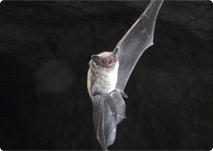New insights into behaviour, environment
 All night long, bats swoop over our landscape consuming insects, but they do this in secret, hidden from our view. Until recently, scientists have been unable to bring their ecosystem out of the dark but thanks to new genetic techniques, researchers from the University of Bristol and Biodiversity Institute of Ontario, Canada, have been able to reconstruct the environment supporting these elusive creatures.
All night long, bats swoop over our landscape consuming insects, but they do this in secret, hidden from our view. Until recently, scientists have been unable to bring their ecosystem out of the dark but thanks to new genetic techniques, researchers from the University of Bristol and Biodiversity Institute of Ontario, Canada, have been able to reconstruct the environment supporting these elusive creatures.
Working at three sites in Southern Ontario (Canada), the team of students and scientists monitored the diet of little brown bats (Myotis lucifugus) from colonies living on agricultural land and at a conservation site. Guano (bat faeces) was continually collected under each roost from May to August.
Back in the lab at the Biodiversity Institute of Ontario in Canada, the team extracted insect DNA from the material and sequenced a "DNA barcode" which is a small region of DNA that can be used to identify animal species. The team then matched these unknown insect sequences in bat guano to a library of known sequences to identify which insect prey the bats where eating.
"This technology is very new," says lead author Dr Elizabeth Clare of the University of Bristol's School of Biological Sciences. "It gives us an entirely new insight into the bats' behaviour. Instead of just finding they ate a moth or a mayfly, we now know exactly what species of insect it was, providing us with important information on their habitat."
Using this technique, the team found that the bats rely heavily on insects from aquatic environments. They were also able to identify the exact species of insect prey, which revealed that different colonies exploit different source water, sometimes rivers and streams, sometimes ponds, depending on the local landscape.
"Some of the insects they eat come from very specific habitats and have specific pollution tolerances. These 'environmental indicators' allow us to reconstruct exactly what their foraging habitat was like," explains Dr Clare. "It's a very non-invasive way of tracking their behaviour - a bit like looking through someone's rubbish bin to see where they shop."
The bats foraged very locally - travelling only a few hundred meters to catch insect prey. The species they ate changed seasonally and the shifts corresponded to the phases of pregnancy and lactation in the bats.
The researchers also identified that bats in agricultural habitats seemed to have a more restricted diet of fewer insect species than bats in a conservation area even though the source water in all areas was of good quality.
Dr Clare added, "This suggests that even small conservation projects can have an impact on the entire food chain. This site has a small patch of forest, a small pond and a dedicated group of conservation workers. All these components seem to have generated a good environment for the insects and thus the bats they support."
The results of this research are becoming more and more important as this bat species is under serious threat from the spread of a fungal disease called 'white nose syndrome' which may threaten the survival of these populations in North America. Dr Clare comments: "Understanding how the bats exist within the ecosystem is vital to our conservation goals."
The research is published in the journal Molecular Ecology.
Paper
"Eating local: influences of habitat on the diet of little brown bats (Myotis lucifugus)" by Elizabeth Clare, Brittany Barber, Bernard Sweeney, Paul Hebert and Brock Fenton is published in the journal Molecular Ecology and is available from the authors on request.
Author contact
Dr. Elizabeth Clare is now based in the School of Biological Sciences at the University of Bristol (UK), tel + 44 (0) 117 954 5909
Image
An image of a little brown bat (Myotis lucifugus) is available here. Permission to reproduce the image is hereby granted for the use singularly and once for publication in connection with this press release. Any further use or reprint must be applied for beforehand. No other use permitted. Copyright: "Copyright M. Brock Fenton". Credit must be given to the M. Brock Fenton. Please forward one reference copy free to the University of Bristol, Press Office, Tyndall Avenue, Bristol, BS8 1TH.
Funders
The project has been funded by the Natural Sciences and Engineering Research Council of Canada, Genome Canada through the Ontario Genomics Institute, Biodiversity Institute of Ontario, Environment Canada and the Bat Conservation International
Contacts
University of Bristol, Public Relations Office, Communications & Marketing Services. Press Office contacts: tel +44 (0)117 331 0892, Caroline Clancy or Hannah Johnson.
International Barcode of Life Project (iBOL) Media Office, Tel. 1-519-824-4120 ext. 56587 , Cell 1-416-452-6016
Contact: John Chenery, Director of Media and Communications.


 Food forensics: DNA barcodes link habitat quality to bat diet
Food forensics: DNA barcodes link habitat quality to bat diet